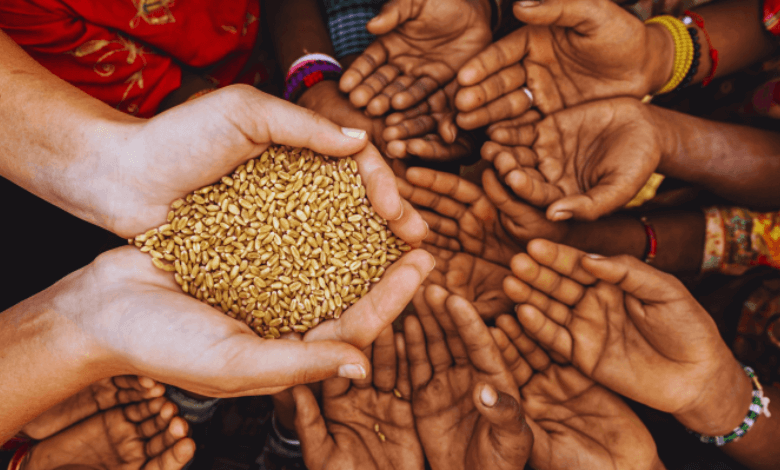Why is the Global Food Crisis Getting Worse? It’s Because of Climate Change.

As households around the world grapple with essential food shortages and skyrocketing prices, a grim question emerges: How can one prepare a meal when a staple ingredient is prohibitively expensive? This conundrum is becoming an everyday reality, as countries enact restrictions on food exports to safeguard their domestic supplies.
The convergence of factors including the Ukraine conflict, El Niño’s impact on food production, and the escalating climate crisis is intensifying this global food crisis.
Testaments of Food Crisis Victims
For 28-year-old Caroline Kyalo, employed in a Nairobi salon, the challenge lies in providing meals for her two children without the luxury of affordable onions.
Stringent export restrictions imposed by neighboring Tanzania have sent onion prices soaring, tripling the cost for Kyalo and countless others. In a bid to cope, Kyalo initially turned to spring onions, only to find them also beyond her budget.
Essential items like cooking oil and corn flour followed suit, becoming increasingly unaffordable. Consequently, she reluctantly resorted to cooking just one meal a day.
Despite Kenya’s fertile lands and a substantial workforce, a combination of high production and transportation costs, exacerbated by the worst drought in decades, has led to a sharp decline in local food production.
Additionally, the preference for more cost-effective and longer-lasting Tanzanian red onions further reduced Kenya’s onion production. By 2014, Kenya was sourcing half of its onions from Tanzania, according to the U.N. Food Agriculture Organization.
At Nairobi’s primary food market, Wakulima, Tanzanian onions reached their highest prices in seven years, causing considerable distress among traders and consumers alike.
While some traders have adapted by turning to Ethiopian produce and alternative vegetables, others like Timothy Kinyua, a steadfast onion vendor, remain committed to selling this essential ingredient, stating, “It’s something we can’t cook without.”
Tanzania’s onion export limits this year contribute to a growing “contagion” of food restrictions worldwide. Nations concerned about supply shortages and rising demand for their produce are enacting a multitude of food export restrictions, ranging from outright bans to taxing exports, according to Joseph Glauber, senior research fellow at the International Food Policy Research Institute.
As households around the world grapple with essential food shortages and skyrocketing prices, a grim question emerges: How can one prepare a meal when a staple ingredient is prohibitively expensive? This conundrum is becoming an everyday reality, as countries enact restrictions on food exports to safeguard their domestic supplies.
The convergence of factors including the Ukraine conflict, El Niño’s impact on food production, and the escalating climate crisis is intensifying this global food crisis.
Testaments of Food Crisis Victims
For 28-year-old Caroline Kyalo, employed in a Nairobi salon, the challenge lies in providing meals for her two children without the luxury of affordable onions. Stringent export restrictions imposed by neighboring Tanzania have sent onion prices soaring, tripling the cost for Kyalo and countless others. In a bid to cope, Kyalo initially turned to spring onions, only to find them also beyond her budget.
Essential items like cooking oil and corn flour followed suit, becoming increasingly unaffordable. Consequently, she reluctantly resorted to cooking just one meal a day.
Despite Kenya’s fertile lands and a substantial workforce, a combination of high production and transportation costs, exacerbated by the worst drought in decades, has led to a sharp decline in local food production.
Additionally, the preference for more cost-effective and longer-lasting Tanzanian red onions further reduced Kenya’s onion production. By 2014, Kenya was sourcing half of its onions from Tanzania, according to the U.N. Food Agriculture Organization.
At Nairobi’s primary food market, Wakulima, Tanzanian onions reached their highest prices in seven years, causing considerable distress among traders and consumers alike.
While some traders have adapted by turning to Ethiopian produce and alternative vegetables, others like Timothy Kinyua, a steadfast onion vendor, remain committed to selling this essential ingredient, stating, “It’s something we can’t cook without.”
Tanzania’s onion export limits this year contribute to a growing “contagion” of food restrictions worldwide. Nations concerned about supply shortages and rising demand for their produce are enacting a multitude of food export restrictions, ranging from outright bans to taxing exports, according to Joseph Glauber, senior research fellow at the International Food Policy Research Institute.
Globally, 41 food export restrictions from 19 countries are in effect, affecting the availability and affordability of essential items. For instance, India’s suspension of rice shipments earlier this year created a significant shortfall in global rice exports. In response, Myanmar, a major rice supplier, halted some of its own rice exports.
India also imposed restrictions on onion exports after erratic rainfall, fueled by climate change, damaged crops. This led to skyrocketing onion prices in neighboring Bangladesh, forcing authorities to scramble for new sources.
Elsewhere, Spain’s drought impacted olive oil production, prompting European buyers to turn to Turkey. Consequently, olive oil prices surged in Spain, resulting in export restrictions. Similarly, Morocco, grappling with drought and a recent devastating earthquake, halted the export of onions, potatoes, and tomatoes in February.
The current global food crisis bears striking resemblances to the food price spikes of 2007-2008. However, a crucial difference is the dwindling buffer of food stocks and the looming threat of climate change. According to Glauber, former chief economist at the U.S. Department of Agriculture food supplies are increasingly at risk of falling short of demand and triggering price spikes.
Main Factors Why Food Prices Are Soaring
Three main factors will determine food prices worldwide: the course and duration of El Niño, weather-induced crop damage, and the Ukraine-Russia conflict. Both Ukraine and Russia are major global suppliers of wheat, barley, sunflower oil, and other food commodities, especially to developing nations where food prices are rising, leading to increased food insecurity.
The uncertainty surrounding El Niño, a natural phenomenon exacerbating extreme weather events, including droughts and floods, poses significant challenges to food production. Climate change further amplifies its impact, making predictions difficult.
India’s recent record-dry August and Thailand’s ongoing drought threaten the world’s sugar supplies. Both countries are among the largest sugar exporters after Brazil. The reduced rainfall in India dashed hopes for a new rice harvest in October, thereby prolonging trade restrictions and unstable prices.
Countries heavily reliant on food imports, like the Philippines, are particularly vulnerable. Importing 14% of its food, the Philippines faces additional risks due to storm damage to crops. Rice prices surged by 8.7% in August from the previous year, compounding the struggles of food store owners in the capital of Manila, where customers are buying smaller quantities due to rapidly increasing prices.
Cynthia Esguerra, a resident of Manila, has been forced to choose between food and medicine for her health issues, all while struggling to afford essential supplies. The climate risks extend beyond rice, impacting all crops requiring stable rainfall, as well as livestock. This creates a vicious cycle of food scarcity and rising prices, increasing the likelihood of spoilage.
Additionally, ongoing grain exports from Ukraine remain unresolved, causing further shortages in livestock feed and fertilizer. Russia’s withdrawal from a wartime agreement, ensuring the safe transport of Ukrainian grain through the Black Sea, has compounded global food security challenges. With limited shipping routes for Ukrainian exports, food affordability is increasingly uncertain.
ALSO READ: Is Apple’s Supply Chain Making Climate Change Worse?
As the world grapples with the intricate web of factors affecting food prices, it becomes apparent that global food security is at a critical juncture.
The ongoing interplay of climate change, geopolitical conflicts, and supply chain disruptions signals an era of heightened volatility in food prices—a stark reminder that the path to food security remains uncertain.



